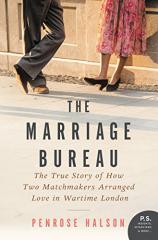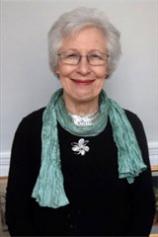The Marriage Bureau: How Two Matchmakers Arranged Love in Wartime London
Review
The Marriage Bureau: How Two Matchmakers Arranged Love in Wartime London
When she was 25 and unmarried, Penrose Halson's mother sent her to a marriage service (pre-Internet) for help. Years later, Halson (author of HAPPILY EVER AFTER: How to Meet Your Match) and her husband had the chance to take over that same bureau, acquiring the original records starting from its inception in 1939. The result is a fascinating look at the matrimonial aspirations and frustrations of an earlier generation, with special focus on wartime London.
The two women who started the agency were educated young ladies from good families --- Mary Oliver and Heather Jenner --- who could have done the proper thing: marry and conform. But neither was able to stick to those norms. Both found themselves at loose ends, tired of partying and looking for a means of supporting themselves. It was then that Mary seized on the idea of starting a marriage agency, a suggestion made to her by a kindly uncle living abroad who saw the need for such a service, and knew his niece was never going to fit the standard pattern of matrimonial bliss and might need an occupation. In the British colonial framework, young men were sent away to work in foreign climes with scant hope of encountering a suitable mate. Back home, women were disregarded, their real needs overlooked in the patriarchal system. Mary and Heather (both had assumed new identities so as not to embarrass their families by running a business) found rich pickings for the marriage game.
"...a fascinating look at the matrimonial aspirations and frustrations of an earlier generation, with special focus on wartime London."
Halson’s book is told through multiple matchmaking tales. One example is Etherelda Pomfret, twice widowed, very choosy and insistent that her chosen mate speak perfect French and be “a connoisseur of objets d’art” --- but most of all, “no cads or bounders!” Mary and Heather came up with several candidates, the first of whom found Etherelda far too bossy. The next, a brigadier, decided he would try bossing her, and immediately demanded that she get rid of her cats. She acceded, and the Marriage Bureau had another triumph. One potential “client” came in to the little fifth floor Bond Street office only to demonstrate her magical “bust bodice” (by baring her chest) in hopes of making sales to less endowed marriage-seeking ladies. American flyboy Hank dropped in to offer the Bureau his gift of gratitude for finding him a suitable spouse --- a hunk of metal, souvenir of a recent air battle. “Got the bastards” was his proud pronouncement.
In addition to the many amusing, often poignant case studies, Halson details the interview process (Mary tended to get a bit too emotionally involved, but Heather seemed born to the task); fee structure (one fee for the interview and search, another payable if a marriage took place); the gradual expansion of the cramped office space to include a real typewriter after months of scribbling everything by hand; and the changes of personnel over the years up to the present.
There is an enjoyable index listing requirements of female and male clients from 1939 to 1949. Women’s needs for a spouse included: someone in Sussex who is not too keen on dancing; a bon vivant who likes his coffee and liqueur; in the army or RAF; someone with a title; if Englishman, must not be prejudiced against Irish; not hearty, perhaps absent-minded; good prospects after the war. Men sought: a nice stylish girl, not too brainy, with the appearance of a West End mannequin; a girl who knows her way about as after four years in the East I feel out of things; not frigid; nobody called Florence; fond of home life --- Army life has made me appreciate such.
Following these two lists are Interviewer’s Comments: Gent, mad, amiable rotter, beard; very nice honest-to-goodness superior working class; says she’s sex-starved; legs badly burned in the Blitz; cheque bounced.
Halson believes that Mary and Heather's Marriage Bureau offered hope in times of grave crisis. Started by two twenty-somethings with little business acumen, it endured because the women learned as they went along and never lost their indomitable spirit, mirroring that of the British people during those trying years.
Reviewed by Barbara Bamberger Scott on May 12, 2017
The Marriage Bureau: How Two Matchmakers Arranged Love in Wartime London
- Publication Date: May 2, 2017
- Genres: History, Nonfiction
- Paperback: 352 pages
- Publisher: William Morrow Paperbacks
- ISBN-10: 0062562665
- ISBN-13: 9780062562661




